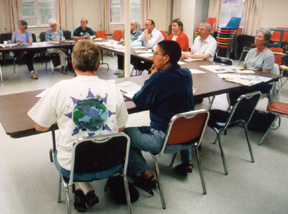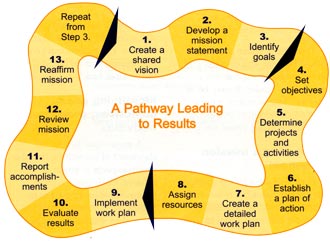Bulletin #6107, Vision, Mission, Goals and Objectives…Oh My!
GroupWorks: Getting Things Done in Groups
Bulletin #6107, Vision, Mission, Goals & Objectives…Oh My! (PDF)
Developed by Deborah Killam, Extension educator, University of Maine Cooperative Extension.
For information about UMaine Extension programs and resources, visit extension.umaine.edu.
Find more of our publications and books at extension.umaine.edu/publications/.
 Table of Contents
Table of Contents
- What you will learn
- Creating a shared vision
- Developing a mission statement
- Identifying goals, objectives, projects, and activities
- Developing an action plan
- Resources
- References
What you will learn:
- How to encourage greater focus on issues of importance to a group.
- Why a shared vision is important to a group’s success.
- What a mission statement should consist of and how it can be used.
- The importance of identifying goals and setting objectives.
- How strategic thinking and action planning tools help to produce results.
We are a nation formed from the bold volunteer spirit of the people. Our communities continue to depend upon people coming together to volunteer—to serve. “To volunteer is to choose to act in recognition of a need, with an attitude of social responsibility and without concern for monetary profit, going beyond one’s basic obligations.”1
The information in this fact sheet can help groups become more productive. To make the best of everyone’s desire to make a difference, group members need to create a shared vision, develop a mission statement, and commit to identified goals, objectives and plan of action.
As a starting point, when planning for a group’s future, members may want to consider the following questions:
- Where have we been?
- Where are we now?
- Where do we want to be?
- How do we want to get there?
- How will we know when we have arrived at our destination?
The success of a group may depend upon bringing people together, both physically and philosophically. Our view of the world is influenced by the values we hold. Our values become the basis for our personal vision, mission, goals, objectives and actions. The group needs to reconcile differing perspectives, find common ground and create a shared vision.
Creating a shared vision

A group’s shared vision
- communicates a sense of purpose;
- expresses what is important and why;
- focuses on the future;
- reflects the shared values of group members; and
- uses pictures, images and words to bring the vision to life.
The shared vision statement should be clear and concise, and create a visual image in the mind of the reader. It may be as brief as a few words or a more detailed collection of points that create the desired visual image.
Blueprint for a shared vision
What you will need: blank sheets of unlined paper, markers or pencils in assorted colors, wall space to display group work.
- Provide each person with a blank sheet of unlined paper and colored markers or pencils.
- Have each person take a moment to visualize what their community would look like if the issues or problems of concern to the group were resolved.
- Ask each person to either draw a picture or list descriptive words that represent their community vision.
- Display all work on an open wall.
- Have each person briefly explain his or her vision.
- Have group members identify the common theme(s).
- Use the themes to craft a shared vision statement.
Developing a mission statement
How will your group reach this shared vision? A mission statement could tell us this. The statement becomes a tool to communicate the group’s purpose to others. A mission statement will tell people 1) what you do, 2) for whom do you do it, and 3) how you will get it done. The mission statement
- sets the group’s direction;
- is clear and concise;
- is realistic;
- reflects the values and beliefs of the group;
- demonstrates a commitment to serving others;
- is inspirational; and
- is action oriented.
Working to develop a mission statement will produce additional benefits. The process can generate enthusiasm and excitement for the work at hand.
Blueprint for a mission statement
- Think about your group or an organization you are familiar with.
- Write a mission statement, using the example and table provided below as a guide.
Example:
| Group or organization’s Name | What you do | For whom do you do it | How will you get it done |
|---|---|---|---|
| University of Maine Cooperative Extension |
|
|
|
| Mission Statement | To help Maine people improve their lives through an educational process that uses research-based knowledge focused on issues and needs. | ||
Your group:
| Group or organization’s Name | What you do | For whom do you do it | How will you get it done |
|---|---|---|---|
| Mission Statement | |||
Identifying goals, objectives, projects, and activities
A group goal is a broad statement of something that the group expects to attain or achieve. Goals may be short, intermediate or long-term in nature. Well-written goals are believable, attainable and based on identified needs.
Objectives are statements of specific, measurable and attainable outcomes that contribute to the achievement of a particular goal. Outcome-based objectives focus on
- changing people’s behavior or circumstances;
- changing something about the community; or
- establishing a process for achieving a particular goal.
- establishing a process for achieving a particular goal.
Blueprint for objectives
- Consider one of your group’s goals
- Write a specific, measurable, attainable objective related to the group goal you selected. Use the example and blank table provided below as a guide.
Example:
| Goal | Do what | To what extent | To whom | By when |
|---|---|---|---|---|
| Improve the in-home safety of older adults | Install grab bars for bathtubs | In 30% of the homes in a given town | For adults 60 years of age or older | By the end of this calendar year |
| Specific, measurable, obtainable objective: By the end of this calendar year, 30% of homes inhabited by residents 60 years of age or older in our town will have bathtub grab bars. | ||||
Your group:
| Goal | Do what | To what extent | To whom | By when |
|---|---|---|---|---|
| Specific, measurable, obtainable objective: | ||||
Developing an action plan
An action planning process helps groups
- see the “big picture;”
- focus on vision, mission, goals and objectives;
- build consensus around planned actions;
- work more efficiently;
- attract human and financial resources; and
- establish short-, intermediate- and long-term plans.
During the planning process, your group may identify additional information or skills that are needed to accomplish group goals. The group can then take steps to acquire what is necessary for success. Other opportunities and barriers to implementing established plans may also surface. These can be considered when finalizing the group’s action plan and project timelines. Operating procedures, policies and incentives may also be needed to support implementation of group plans. Allow time to put these procedures, policies and incentives into practice.
A nine-step action planning process can help your group generate the information it needs to develop a plan of action. Follow these steps for each goal your group has decided to focus upon:
- Describe the goal to be achieved or the problem to be solved.
- Define specific, measurable and attainable outcome-based objectives.
- Research possible projects or activities to address goals and objectives.
- Evaluate the pros and cons for each possibility.
- Select the most appropriate possibility(ies) to implement.
- Detail the tasks that are required to accomplish the project or activity.
- Establish a timeline.
- Allocate resources.
- Assign responsibilities.
Once the plan is complete, projects or activities can be staffed, implemented and evaluated.
This structured approach to your work may seem over-whelming, but the time you spend on the front end of your group’s development will be invaluable over the long haul. The shared vision statement and mission statement will provide the foundation your group needs to productively move into the future. Periodically develop or review group goals, objectives, projects and activities to keep everyone headed in the same direction.
Blueprint for detailed work plan
Possible work plan format:
| Project/activity description | Task(s) to be done | Who is/are the responsible person(s) | Task(s) to be completed by when | Costs, if any | Other |
|---|---|---|---|---|---|
Resources
Bendaly, Leslie. The Facilitation Skills Training Kit. New York: McGraw-Hill, 2000 ISBN 0-07-134734-8.
Ohio State University. Coalition Goal Setting fact sheet (CDFS-4). http://www.ag.ohio-state.edu/ (accessed August 2003).
Nagy, Jenette and Stephen Fawcett. Bill Berkowitz and Jerry Schultz, eds. “Proclaiming Your Dream: Developing Vision and Mission Statements.” Community Tool Box: Part D Chapter 8 Section 2. University of Kansas. http://ctb.ku.edu/en/tablecontents/section_1086.aspx (accessed August 2003).
Axner, Marya. Bill Berkowitz, ed. “Developing and Communicating a Vision.” Community Tool Box: Part E Chapter 14 Section 2. University of Kansas. http://ctb.ku.edu/en/tablecontents/section_1130.aspx (accessed August 2003).
Nagy, Jenette and Stephen Fawcett. Bill Berkowitz and Jerry Schultz, eds. “Creating Objectives.” Community Tool Box: Part D Chapter 8 Section 3. University of Kansas. http://ctb.ku.edu/en/tablecontents/section_1087.htm (accessed August 2003).
Nagy, Jenette and Stephen Fawcett. Bill Berkowitz and Jerry Schultz, eds. “Developing an Action Plan,” Community Tool Box: Part D Chapter 8 Section 5. University of Kansas. http://ctb.ku.edu/en/tablecontents/section_1089.aspx (accessed August 2003).
References
Kathy Walker et al., “Strategic Planning and Mobilizing Resources,” LEADS Curriculum Notebook Unit IV, Module 2 (Kansas State University, 2002).
Hubert H. Humphrey Institute of Public Affairs, University of Minnesota and University of Minnesota Extension Service. “Getting Focused: Vision/Missions/Goals.” Facilitation Resources, Volume 3.
Heimlich Joe E. and Sereana Howard Dresbach. Writing Documents for Community Groups: Bylaws and Standard Operating Procedures. Ohio State University fact sheet.
Maine Department of Human Services, Bureau of Health. “A Plan of Action, Developing a Mission Statement.” Healthy Communities Project Manual, Section 5.
Kansas State University Agricultural Experiment Station and Cooperative Extension Service. “Making Time for Your Community.” Goal Setting fact sheet.
Simon-Brown, Viviane. “Choosing Your Group’s Structure.” Working Together — A Series for People Working Together in Groups. Oregon State University Extension Service.
Nagy, Jenette and Stephen Fawcett. Bill Berkowitz and Jerry Schultz, eds. “An Overview of Strategic Planning or ‘VMOSA’ (Vision, Mission, Objectives, Strategies, and Action Plans).” Community Tool Box: Part D Chapter 8 Section 1. University of Kansas.
1 Susan J. Ellie and Katherine H. Noyes. By The People – A History of Americans as Volunteers (San Francisco, CA: Jossey-Bass Inc., Publishers, 1990), 4.
2 Kathy Walker et. al, “Strategic Planning and Mobilizing Resources,” LEADS Curriculum Notebook Unit IV, Module 2 (Kansas State University, 2002), 1.
3 Walker, 1.
Information in this publication is provided purely for educational purposes. No responsibility is assumed for any problems associated with the use of products or services mentioned. No endorsement of products or companies is intended, nor is criticism of unnamed products or companies implied.
© 2004
Call 800.287.0274 (in Maine), or 207.581.3188, for information on publications and program offerings from University of Maine Cooperative Extension, or visit extension.umaine.edu.
The University of Maine is an EEO/AA employer, and does not discriminate on the grounds of race, color, religion, sex, sexual orientation, transgender status, gender expression, national origin, citizenship status, age, disability, genetic information or veteran’s status in employment, education, and all other programs and activities. The following person has been designated to handle inquiries regarding non-discrimination policies: Sarah E. Harebo, Director of Equal Opportunity, 101 North Stevens Hall, University of Maine, Orono, ME 04469-5754, 207.581.1226, TTY 711 (Maine Relay System).

